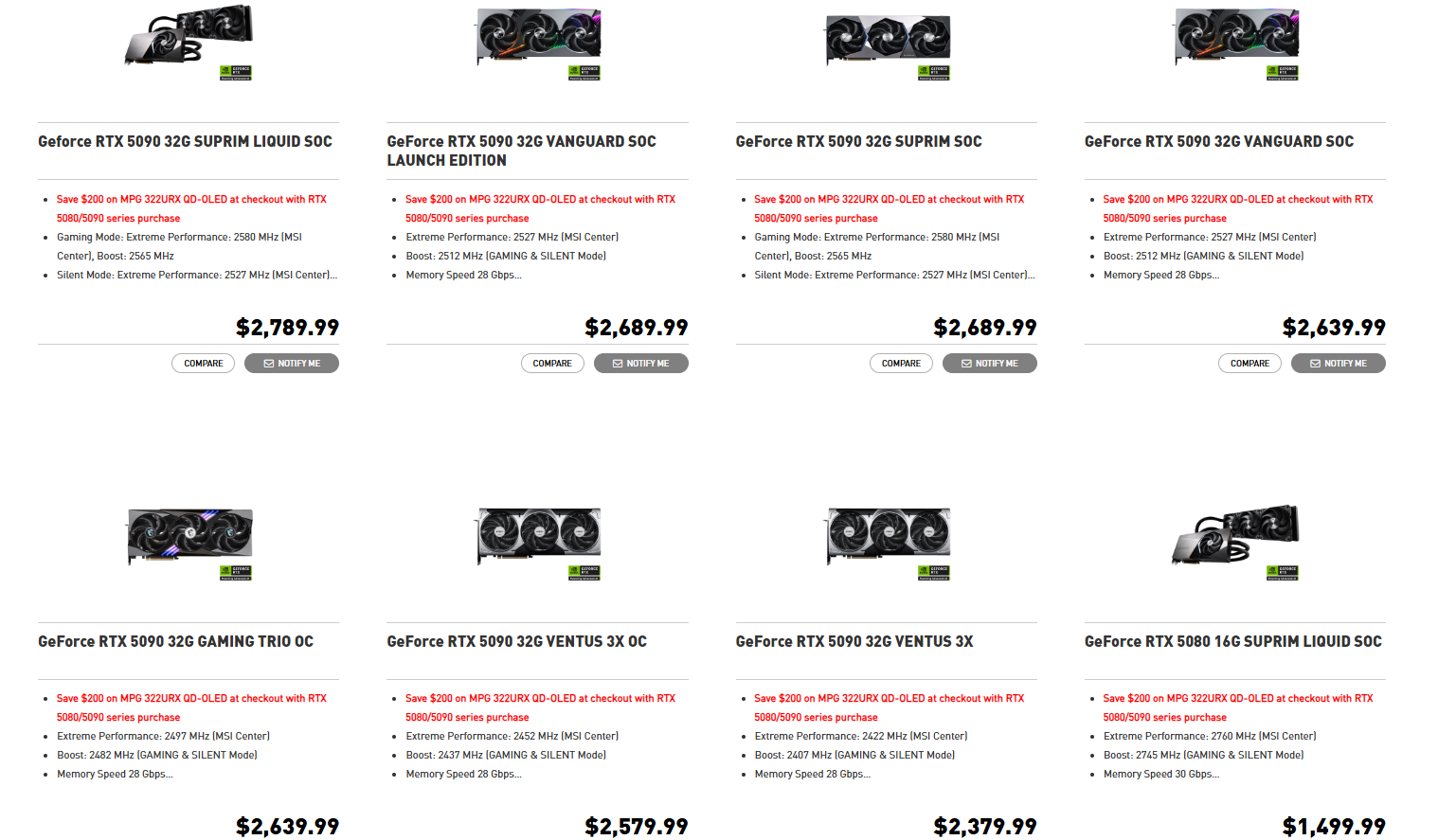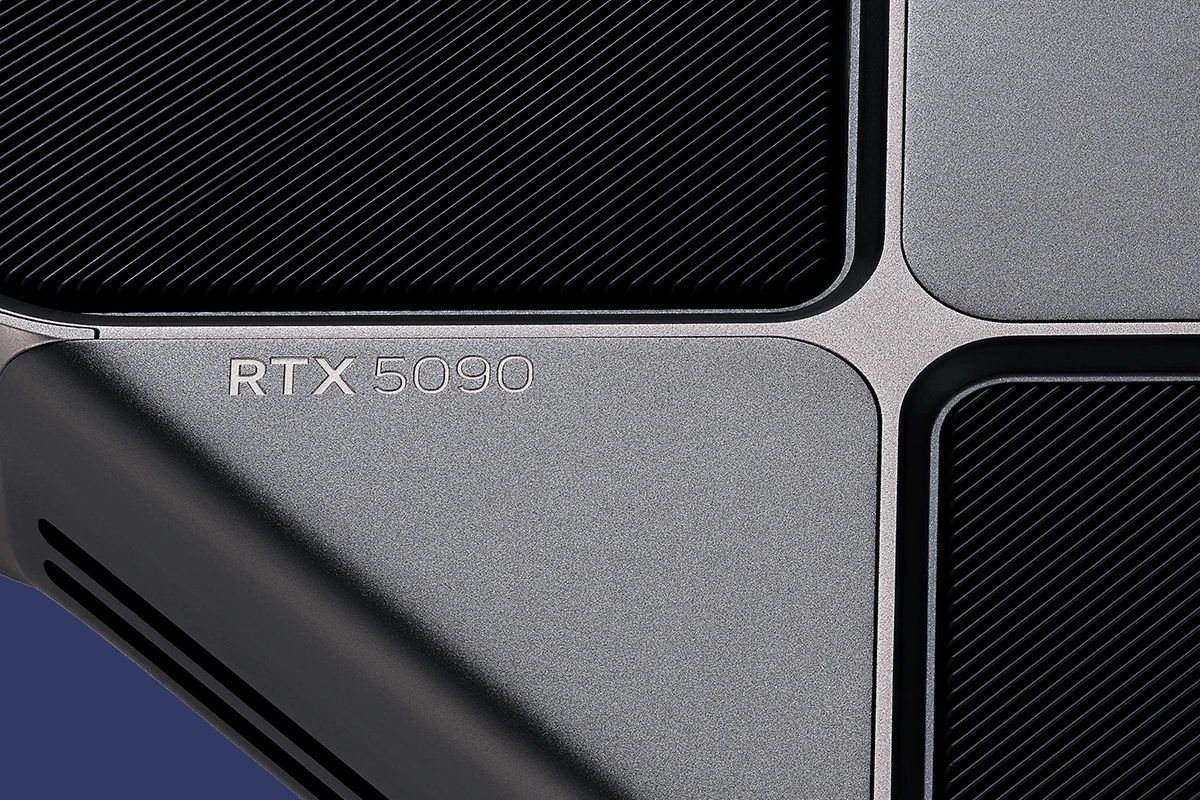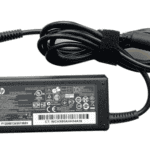GPU enthusiasts face a challenging market as prices for the highly anticipated RTX 5090 GPUs rise due to tariff risks and high demand. Manufacturers like MSI have already increased their website prices by 15-25%, reflecting the current market pressures (that’s nearly $300+ a unit!) The combination of potential tariffs and strong consumer interest has created a perfect storm for price hikes in the high-end GPU market.
NVIDIA and AMD are rushing to ship their next-generation GPUs to US warehouses in China, aiming to avoid impending tariffs that could further increase costs. This urgent push highlights the industry’s concern over maintaining competitive pricing while meeting consumer demand. The RTX 5090, as NVIDIA’s flagship model, stands at the center of this pricing turmoil.
As can be seen at MSI, all the prices have already been increased (even though they are out of stock):

Consumers may need to brace for even higher prices, as some reports suggest that RTX 5090 and 5080 prices have already doubled in certain areas. The supply constraints and potential tariffs could lead to a scenario where premium GPUs become even more expensive and harder to obtain.
Note: We select all our products independently. If you purchase through our links, we may earn a commission.
Pricing Shifts for the RTX 5090
Check RTX 5090 Prices On AmazonTariffs and Price Increases
New graphics cards often come with a hefty price tag, but the Nvidia RTX 5090 is facing additional pressures. Reports from various sources, including listings at major retailers, suggest that prices for the RTX 5090 are already climbing beyond Nvidia’s suggested retail price (MSRP). These increases are likely tied, at least in part, to tariffs. When governments impose tariffs on imported goods, the cost for companies bringing those products into the country goes up. Businesses often pass these added costs along to the consumer, resulting in higher prices at the checkout.
Impact on Consumers
What does this mean for gamers and PC enthusiasts? Simply put, the RTX 5090 might be more expensive than initially anticipated. If you’re on a tight budget, these price hikes could make the 5090 less attainable. It’s wise to shop around and compare prices from different sellers. Also, consider whether the performance jump from your current card, or a less expensive alternative, justifies the higher cost.
Other Contributing Factors
While tariffs appear to be a primary driver, other factors could also be at play. Manufacturing costs, for instance, can fluctuate. Supply chain hiccups, like those experienced in recent years, can also impact pricing. High demand for a new, top-tier GPU can also lead to inflated prices. It’s a complex situation with several moving parts.
Comparing RTX 5090 Models
Different manufacturers, like ASUS and MSI, offer their own versions of the RTX 5090. These cards often have slightly different features, cooling solutions, and clock speeds. This leads to variations in performance and, of course, price.
| Feature | Example 1 (Hypothetical) | Example 2 (Hypothetical) |
|---|---|---|
| Manufacturer | ASUS | MSI |
| Cooling Solution | Triple Fan | Liquid Cooled |
| Clock Speed | Boost Clock: 2.6 GHz | Boost Clock: 2.7 GHz |
| Price (USD) | $1,700 | $1,900 |
It’s important to research and compare different models to find the best fit for your needs and budget. Consider factors like cooling performance, noise levels, and overclocking potential.
Navigating the GPU Market
The GPU market can be volatile. Prices can change rapidly based on various factors. If you’re looking to buy an RTX 5090, keep these tips in mind:
- Be Patient: If prices are too high, consider waiting. Prices may stabilize or even decrease over time.
- Compare Prices: Shop around at different retailers, both online and brick-and-mortar stores.
- Consider Alternatives: Evaluate other GPUs in the RTX 50 series or even previous generations. You might find a card that offers excellent performance at a lower price.
- Set a Budget: Determine how much you’re willing to spend and stick to it. It’s easy to get caught up in the hype, but it’s important to be financially responsible.
The Role of Tariffs in Tech Pricing
Tariffs are taxes on imported goods. They are often imposed to protect domestic industries or to achieve other economic or political goals. However, tariffs can have a direct impact on consumers by increasing the prices of imported products, including electronics like GPUs. The impact of tariffs can be complex, and there’s ongoing debate about their overall effects on the economy. Understanding how tariffs work can help you make informed purchasing decisions. They are one factor, among many, that influence the prices you pay for tech products.
Key Takeaways
- RTX 5090 GPU prices are increasing due to tariff risks and high demand.
- Manufacturers are preemptively raising prices by 15-25% on their websites.
- Supply shortages may lead to further price increases and limited availability.
Market Dynamics and Price Fluctuations
The RTX 5090 GPU market faces significant price increases due to tariff risks and high demand. These factors have led manufacturers like MSI to raise their website prices by 15%-25%.
Impact of Tariffs on GPU Pricing
Tariff risks have pushed GPU prices higher. The Trump Administration’s trade policies have affected the tech industry, including graphics cards.
Consumer prices for RTX 5090 GPUs now exceed their MSRP by a wide margin. This increase stems from import taxes on electronic components from China.
Manufacturers are passing these costs to consumers. Some companies have moved production to avoid tariffs, but this hasn’t fully offset the price hikes.
The Consumer Technology Association has warned about the impact on US markets. They predict continued price increases for laptops, smartphones, and game consoles as well.
Demand and Supply Chain Considerations
High demand for RTX 5090 GPUs has strained supply chains. Manufacturers struggle to meet consumer needs, leading to shortages and inflated prices.
Supply chain bottlenecks have slowed production. This has resulted in limited stock at retailers and online stores.
Some companies are stockpiling GPUs in US warehouses. This strategy aims to buffer against future tariff increases but reduces current market supply.
The imbalance between supply and demand has allowed sellers to charge premium prices. Consumers face tough choices between waiting for prices to stabilize or paying inflated costs.
Nvidia has acknowledged these issues. They expect stock-outs for the RTX 5090 and 5080 models due to significant demand.
Manufacturer Responses and Consumer Impact
GPU manufacturers and retailers have taken varied approaches to address the pricing and supply challenges of the RTX 5090. These responses have significant implications for consumers looking to purchase high-end graphics cards.
MSI’s Pricing Strategy and Its Implications
MSI has implemented substantial price increases across its RTX 5090 lineup. The company’s website prices have risen by 15%-25%, affecting models such as the GAMING TRIO OC and SUPRIM LIQUID SOC. This strategy aims to offset potential tariff impacts and capitalize on high demand.
For consumers, these increases translate to significantly higher costs. The MSI SUPRIM LIQUID SOC, for example, now retails at $2,499.99. Budget-conscious gamers may find these prices prohibitive.
MSI’s move could influence other manufacturers. Asus and Gigabyte may follow suit to protect profit margins. This trend could lead to a market-wide increase in high-end GPU prices.
Alternative Options and Market Predictions
Consumers facing steep RTX 5090 prices have several alternatives. The RTX 5080 offers strong performance at a lower price point. AMD’s upcoming Radeon RX 9000 series may provide competitive options.
Market analysts predict continued supply constraints for next-gen GPUs. This shortage could extend to the RTX 5080 and 5070 TI. Prices may remain elevated throughout 2025.
Some consumers might consider delaying purchases. Waiting for market stabilization could lead to better pricing. Others may explore the used GPU market for previous-gen cards.
Retailers like Dell and HP might bundle RTX 5090s with pre-built systems. This approach could offer better value for consumers seeking complete upgrades.







